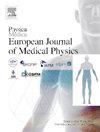Automated field-in-field planning for tangential breast radiation therapy based on digitally reconstructed radiograph
IF 3.3
3区 医学
Q1 RADIOLOGY, NUCLEAR MEDICINE & MEDICAL IMAGING
Physica Medica-European Journal of Medical Physics
Pub Date : 2025-05-12
DOI:10.1016/j.ejmp.2025.104994
引用次数: 0
Abstract
Background
The tangential field-in-field (FIF) technique is a widely used method in breast radiation therapy, known for its efficiency and the reduced number of fields required in treatment planning. However, it is labor-intensive, requiring manual shaping of the multileaf collimator (MLC) to minimize hot spots.
Purpose
This study aims to develop a novel automated FIF planning approach for tangential breast radiation therapy using Digitally Reconstructed Radiograph (DRR) images.
Methods
A total of 78 patients were selected to train and test a fluence map prediction model based on U-Net architecture. DRR images were used as input data to predict the fluence maps. The predicted fluence maps for each treatment plan were then converted into MLC positions and exported as Digital Imaging and Communications in Medicine (DICOM) files. These files were used to recalculate the dose distribution and assess dosimetric parameters for both the PTV and OARs.
Results
The mean absolute error (MAE) between the predicted and original fluence map was 0.007 ± 0.002. The result of gamma analysis indicates strong agreement between the predicted and original fluence maps, with gamma passing rate values of 95.47 ± 4.27 for the 3 %/3 mm criteria, 94.65 ± 4.32 for the 3 %/2 mm criteria, and 83.4 ± 12.14 for the 2 %/2 mm criteria. The plan quality, in terms of tumor coverage and doses to organs at risk (OARs), showed no significant differences between the automated FIF and original plans.
Conclusion
The automated plans yielded promising results, with plan quality comparable to the original.
基于数字重建x线照片的切向乳房放射治疗的自动场对场规划
切线场-场技术是一种广泛应用于乳房放射治疗的方法,以其高效和减少治疗计划所需的场数而闻名。然而,它是劳动密集型的,需要手动塑造多叶准直器(MLC),以尽量减少热点。目的:本研究旨在开发一种新的自动FIF规划方法,用于使用数字重建x线摄影(DRR)图像进行切向乳房放疗。方法选择78例患者,对基于U-Net架构的影响图预测模型进行训练和测试。DRR图像作为输入数据预测影响图。然后将每个治疗方案的预测影响图转换为MLC位置,并导出为医学数字成像和通信(DICOM)文件。这些文件用于重新计算PTV和OARs的剂量分布和评估剂量学参数。结果预测结果与原始结果的平均绝对误差(MAE)为0.007±0.002。伽玛分析结果表明,预测结果与原始通量图吻合较好,3% /3 mm标准的伽玛合格率为95.47±4.27,3% /2 mm标准的伽玛合格率为94.65±4.32,2% /2 mm标准的伽玛合格率为83.4±12.14。在肿瘤覆盖率和危及器官(OARs)的剂量方面,计划质量在自动FIF和原始计划之间没有显着差异。结论自动化方案效果良好,方案质量与原方案相当。
本文章由计算机程序翻译,如有差异,请以英文原文为准。
求助全文
约1分钟内获得全文
求助全文
来源期刊
CiteScore
6.80
自引率
14.70%
发文量
493
审稿时长
78 days
期刊介绍:
Physica Medica, European Journal of Medical Physics, publishing with Elsevier from 2007, provides an international forum for research and reviews on the following main topics:
Medical Imaging
Radiation Therapy
Radiation Protection
Measuring Systems and Signal Processing
Education and training in Medical Physics
Professional issues in Medical Physics.

 求助内容:
求助内容: 应助结果提醒方式:
应助结果提醒方式:


